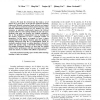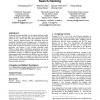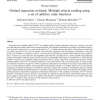82 search results - page 3 / 17 » Learning a ranking from pairwise preferences |
COLT
2008
Springer
13 years 7 months ago
2008
Springer
This paper describes an efficient reduction of the learning problem of ranking to binary classification. The reduction guarantees an average pairwise misranking regret of at most t...
ICDM
2010
IEEE
13 years 3 months ago
2010
IEEE
We study the retrieval task that ranks a set of objects for a given query in the pairwise preference learning framework. Recently researchers found out that raw features (e.g. word...
NAACL
2010
13 years 3 months ago
2010
The goal of this work is to integrate query similarity metrics as features into a dense model that can be trained on large amounts of query log data, in order to rank query rewrit...
CIKM
2009
Springer
14 years 1 days ago
2009
Springer
Traditional boosting algorithms for the ranking problems usually employ the pairwise approach and convert the document rating preference into a binary-value label, like RankBoost....
EOR
2008
13 years 5 months ago
2008
We present a new method, called UTAGMS , for multiple criteria ranking of alternatives from set A using a set of additive value functions which result from an ordinal regression. ...



